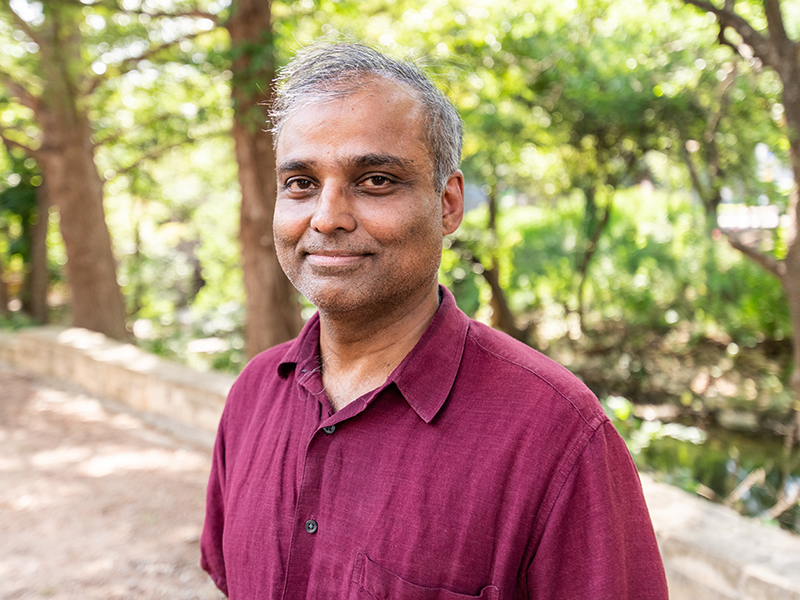The National Academy of Engineering has elected S.V. Sreenivasan, professor in the Walker Department of Mechanical Engineering at The University of Texas at Austin, and three UT alumni as part of the Class of 2021.
Sreenivasan is being recognized by the academy for his innovation and entrepreneurship in industrial deployment of nanoimprint lithography equipment, having pioneered the creation of nanoscale manufacturing systems that have enabled broad commercial deployment of nanoimprint lithography technology.

S.V. Sreenivasan, professor in the Cockrell School of Engineering’s Walker Department of Mechanical Engineering
“S.V. is renowned for his technical innovations and his leadership in nanomanufacturing,” said Sharon L. Wood, dean of the Cockrell School of Engineering and NAE member. “Through his inventions and commercial developments, he has truly exhibited the university’s motto — What starts here changes the world — and we are extremely proud of his accomplishments and election to the academy.”
Membership in the National Academy of Engineering is one of the highest professional distinctions for an engineer, honoring those who have made outstanding contributions to engineering research and practice, including pioneering of new and developing fields of technology and making major advancements in engineering. This year, 106 new members and 23 foreign members were elected.
James Barnard, B. Gentry Lee and Rachel Segalman, all graduates of The University of Texas at Austin, were also elected to the NAE this year.
During the past decade, 16 UT Austin professors have been elected into the NAE, and the university has 46 current and retired members.
About the Four New National Academy Members
S.V. Sreenivasan holds the Joe C. Walter Jr. Chair in Engineering in the Cockrell School of Engineering’s Walker Department of Mechanical Engineering. His research in high throughput nanomanufacturing is applied to electronics, photonics, flexible and wearable devices, and emerging biomedical and clean energy applications. Sreenivasan is the director of the UT-led NASCENT Center, a multi-university National Science Foundation research center that develops nanomanufacturing systems for mobile computing and mobile energy technologies. He co-founded Molecular Imprints, a nanopatterning company spun out of his research at UT that was acquired by the Canon Corporation in 2014. Sreenivasan also currently serves as chief technologist for Canon Nanotechnologies. He holds more than 100 U.S. patents and has received numerous recognitions for his work, including the American Society of Mechanical Engineers’ Design Award and Leonardo da Vinci Award, the TAMEST O’Donnell Award for Technology Innovation, the Technology Pioneer Award by the World Economic Forum, and he was named a fellow of the National Academy of Inventors. Sreenivasan received his bachelor’s degree in mechanical engineering from the National Institute of Technology, Trichy, India, and his Ph.D. in mechanical engineering from The Ohio State University.
James Barnard (M.S. Environmental Engineering 1969) is the global practice and technology leader at Black & Veatch, a role he has served in for over 20 years. He was recognized by the NAE for the development and implementation of biological nutrient removal in water treatment. The biological nutrient removal processes he developed have been adopted around the world to reduce the environmental impact of nitrogen and phosphorus in municipal wastewater. Barnard is a distinguished member of the American Society of Civil Engineers, an honorary member of the American Academy of Environmental Engineers and Scientists, and a distinguished fellow of the International Water Association. He is a member of the Academy of Distinguished Alumni in the Cockrell School’s Department of Civil, Architectural and Environmental Engineering and holds honorary degrees from several universities. He received his B.Sc. in civil engineering from the University of Stellenbosch, RSA, his M.S. in environmental engineering from The University of Texas at Austin and his Ph.D. in water resources and environmental engineering from Vanderbilt University.
B. Gentry Lee (B.A. Mathematics 1963) is the chief engineer for solar system exploration at NASA’s Jet Propulsion Laboratory. He was recognized by the NAE for contributions to 20 planetary exploration missions to Mars, Jupiter, asteroids and comets. Over 50 years, Lee provided engineering leadership, operational oversight and intellectual discipline for landmark space exploration missions such as the two Viking orbiters and landers to Mars in the 1970s; the first and, so far, only spacecraft to orbit Jupiter (Galileo and Juno); and the first spacecraft to explore main-belt asteroids and the first to collect and return samples from a comet. Lee co-wrote and narrated the Discovery Channel’s “Are We Alone?” a documentary on life beyond Earth, and, with Carl Sagan, he co-developed the 1980 television series “Cosmos” for which he shared Emmy and Peabody awards. Additionally, he has been recognized with NASA’s Distinguished Service Medal and Exceptional Scientific Achievement Medal, as well as the Simon Ramo Medal from the Institute of Electrical and Electronics Engineers and the Harold Masursky Award from the American Astronautical Society. Lee received his B.S. in mathematics from The University of Texas at Austin, his M.S. in aeronautics and astronautics from the Massachusetts Institute of Technology and his M.Sc. in physics from the University of Glasgow.
Rachel Segalman (B.S. Chemical Engineering 1998) is the Edward Noble Kramer Professor and chair of the Department of Chemical Engineering at the University of California, Santa Barbara. She was recognized by the NAE for contributions to semiconducting block polymers, polymeric ionic liquids and hybrid thermoelectric materials. Her research focuses on controlling the structure and thermodynamics of functional polymers, including semiconducting and bioinspired polymers. Segalman’s work has led to three U.S. patents for inventions that span semiconductor doping technology to energy generation and storage devices. Among her many recognitions, Segalman is a member of the American Academy of Arts and Sciences and fellow of the American Physical Society, as well as the recipient of the Journal of Polymer Science Innovation Award and the Camille Dreyfus Teacher Scholar Award. She is a member of the Academy of Distinguished Chemical Engineers in the Cockrell School’s McKetta Department of Chemical Engineering. Segalman received her B.S. in from The University of Texas at Austin and her Ph.D. from the University of California, Santa Barbara, both in chemical engineering.
